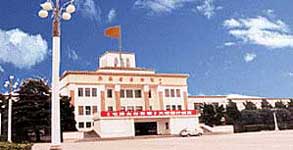 |
The Anhui Provincial Museum, situated on Anqing Road in the provincial city of Hefei Province, provides sound evidence of Anhui's contributions to Chinese culture. Founded in November 1956, the Museum covers an area of 11,580 square meters.
The Museum houses more than 104,684 historical relics, including bronze, pottery, porcelain, gold and silk ware, jade, ancient coins, painting, and the Four Treasures of Study, namely the writing brush, ink stick, ink slab and paper. Among them, there are 10,9126 ancient books and 135 relics of the first grade.
A highlight of the exhibition is the Shang bronze unearthed in Anhui Province, such as an exceptional Shang bronze pot in the shape of an animal unearthed from the Cai Marquis Tomb of the Spring and Autumn Period (770-476BC). The ChuDing(ancient cooking bronze vessel), which is 113 cm high and weighs 400 kilograms, is the biggest and heaviest extant one of its kind since the Zhou Dynasty (11 century -256BC), only secondary to the famous SimuwuDingof the Shang Dynasty (17th century -11th century BC).
A precious celadon bowl, unearthed in 1963 from a Susong County tomb of the Northern Song Dynasty (960-1127), is a rare treasure. Luxie Painting (Reed and Crab Painting) by Liang Zaibang of the Qing Dynasty (1644-1911) is a gem of the art of iron painting.
The Museum's exhibition focuses on the local history and is arranged into three basic displays: Ancient History of Anhui, Revolutionary History of Anhui and Fossils of Ancient Extinct Life in Anhui. In addition to the annual exhibitions, the museum often organizes temporary special exhibitions at home and abroad.
Works published by the Museum includeSelected Masters' Painting,Collections of Anhui Provincial Museum, andExcavations from the Cai Marquis Tomb in Shou County, etc.